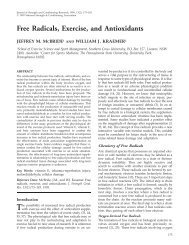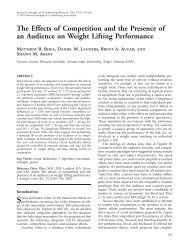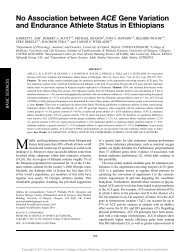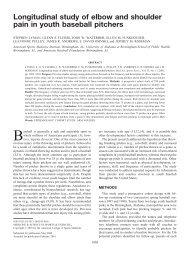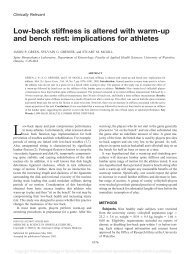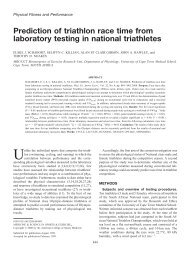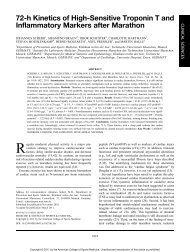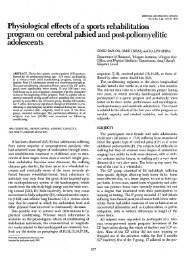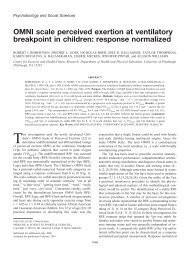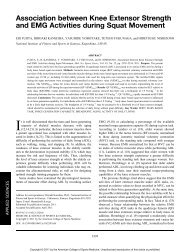Cardiovascular Response to Punching Tempo - Setanta College
Cardiovascular Response to Punching Tempo - Setanta College
Cardiovascular Response to Punching Tempo - Setanta College
You also want an ePaper? Increase the reach of your titles
YUMPU automatically turns print PDFs into web optimized ePapers that Google loves.
106 Kravitz, Greene, Burkett, and Wongsathikun<br />
Table 1. Subject characteristics (mean � SD) and ranges<br />
(N � 18).<br />
Variables Mean � SD Range<br />
Age (y)<br />
Height (cm)<br />
Body weight (kg)<br />
Body fat (%)<br />
HRmax (b·min �1 )<br />
V˙ O2max (ml·kg �1 ·min �1 )<br />
RPEmax (units)<br />
22.0 � 2.8<br />
170.8 � 7.7<br />
71.5 � 12.6<br />
16.1 � 7.3<br />
195.7 � 7.0<br />
41.04 � 6.5<br />
18.6 � 0.8<br />
20–32<br />
157–187<br />
53–92<br />
4.8–28.6<br />
182–220<br />
29.4–52.3<br />
17–20<br />
Figure 1. Heart rate trial responses <strong>to</strong> boxing tempos. 120<br />
� 60, 72, 84, 96 b·min �1 ; 108 � 60, 72 b·min �1 ;96� 60<br />
b·min �1 .<br />
was used for physiological data analysis. In the event<br />
of a significant Wilk’s Lambda, repeated measures<br />
analysis of variance (ANOVA) was used. Where indicated,<br />
posthoc contrast comparisons were used <strong>to</strong><br />
identify significant differences between trial means. A<br />
Friedman nonparametric ANOVA was used <strong>to</strong> analyze<br />
the RPE data. Statistical significance was set a priori at<br />
a probability level of p � 0.05.<br />
Results<br />
Table 1 depicts the subject’s descriptive characteristics.<br />
The MANOVA analysis revealed a significant Wilk’s<br />
Lambda (F � 2.614, p � 0.05). The subsequent univariate<br />
analyses showed a significant trial effect for<br />
HR (F � 5.2, p � 0.05) (Figure 1), VE (F � 4.8, p �<br />
0.05) (Figure 2), and kcal·min �1 (F � 2.8, p � 0.05)<br />
(Figure 3) but not for V˙ O2 (F � 1.6, p � 0.05) (Figure<br />
4). For HR, significance was attained when boxing<br />
tempos varied by �24 b·min �1 , beginning at the 96<br />
b·min �1 speed. Similarly, significance was shown in VE<br />
and kcal·min �1 when the boxing tempo difference was<br />
�24 b·min �1 between trials and the tempo was 84<br />
b·min �1 or above. For RPE, the Friedman nonparamet-<br />
Figure 2. Ventilation trial responses <strong>to</strong> boxing tempos.<br />
120 � 60, 72, 84, 96 b·min �1 ; 108 � 60, 72 b·min �1 ;96� 60<br />
b·min �1 ;84� 60 b·min �1 .<br />
Figure 3. Caloric expenditure trial responses <strong>to</strong> boxing<br />
tempos. 120 � 60, 72 b·min �1 ; 108 � 60 b·min �1 ;84� 60<br />
b·min �1 .<br />
ric test revealed a significant trial difference (p � 0.05),<br />
with mean RPE ranks of 2.3, 2.4, 2.9, 3.2, and 4.2, for<br />
the 60-, 72-, 84-, 96-, 108-, and 120-b·min �1 trials, respectively<br />
(Figure 5). Subjects’ perception of work rose<br />
with each increase in punching tempo for all trials.<br />
Discussion<br />
In this study, 12 men and 6 women, with 30 hours of<br />
fitness boxing experience, completed 6 different<br />
punching trials (60, 72, 84, 96, 108, and 120 b·min �1 ),<br />
wearing 0.34-kg boxing gloves, <strong>to</strong> determine which<br />
tempos were best capable of meeting the ACSM guidelines<br />
for intensity of exercise. The purpose of this<br />
study was <strong>to</strong> provide a physiological basis on which<br />
<strong>to</strong> validate the program design and associated health<br />
benefits of this new exercise modality.




